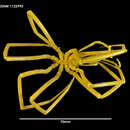pms
nòm ant ël fil


“Colossendeis scotti, sp. n. (Text-fig. 1).
Occurrence. – Station 294, Ross Sea, 158 fathoms; 1 male (Holotype), 1 female.
Description. – Trunk compact, its greatest width across the first pair of lateral processes more than two thirds of its length; lateral processes almost or quite in contact with each other except the third and fourth pairs, which are separated by a small interval; inter-segmental lines very indistinct. Ocular tubercle bluntly conical or rounded at the tip, not occupying more than one-third of width of cephalic segment; eyes dark, sharply defined, anterior pair hardly larger than posterior. On dorsal surface behind ocular tubercle is a convex area defined posteriorly by a crescentic groove; no anterior tubercles on cephalon.
Proboscis decurved, more than twice as long as trunk, narrow and cylindrical for the first quarter of its length, then expanding to nearly twice the width at about the middle, narrowing again to a slight terminal dilation where it measures about five-sixths of its greatest width. Mouth-opening conspicuously wide, the labial teeth apparently smaller, or at least capable of further retraction than in allied species.
Abdomen shorter than greatest diameter of proboscis, decurved, cylindrical, blunt.
Palp with second segment a little less than twice as long as fouth; sixth longer than fifth and nearly four times as long as thick; seventh shorter than its width and less than half as long as eighth; ninth longer than eighth and, together with it, equal to sixth. The whole palp beset with spinules, most numerous on distal segments.
Oviger with fourth segment equal to sixth. Special spines of the distal segments in four rows with some additional spines irregularly placed. At the distal end of last segment is a large curved spine opposed to the claw and forming with it a sub-chelate termination to the limb (Text-fig. 1D). All the segments of the oviger are hispid.
Legs rather stout, femur not more than nine times as long as thick. Femur and first and second tibiae successively descreasing in length. Tarsus a little longer than, and claw nearly equal to, propodus.
Surface of body nearly smooth, proboscis with scattered setae becoming more numerous at the tip, legs set with very short spinules, which are more numerous, and arranged in rows, on the distal segments.
Measurements, in mm. –
Holotype
Male
Female
Length of proboscis
31.0
35.25
Greatest diameter of proboscis
6.25
7.0
Length of trunk
13.75
16.25
Width across first lateral processes
10.0
11.5
Length of abdomen
5.75
6.0
Third right leg –
Coxae
10.5
12.0
Femur
33.5
40.0
First tibia
31.0
37.5
Second tibia
28.25
32.5
Tarsus
11.0
12.0
Propodus
9.5
9.0
Claw
9.0
7.5
Palp –
Second segment
16.25
19.5
Third “
1.28
2.0
Fourth “
8.8
11.2
Fifth “
3.2
4.0
Sixth “
4.24
5.2
Seventh “
0.8
1.12
Eighth “
2.0
2.4
Ninth “
2.24
2.8
Remarks. – In the relative lengths of the distal segments of the palp this species approaches the group of species related to C. angusta, but it differs widely from these not only in the much greater size of the proboscis, but also in the approximation of the lateral processes, in which respect it differs from all the “longitarsal” species except C. proboscidea and the new form described below as C. wilsoni. Among the species of this genus the curious chelate termination of the ovigers is only paralleled, so far as I know, in C. australis, but a similar condition is found in Böhmia chelata (Böhm) and Rhopalorhynchus tenuissimus (Haswell). The labial teeth are found in various degrees of retraction in preserved specimens of other species, and the widely gaping mouth of the specimens described above is partly due to this condition; but I think that the teeth themselves are unusually small and the triangular mouth-frame is relatively larger than in any species with which I have compared it.
The name of this, one of the largest species of Pycnogonida yet brought from Antarctic seas, is chosen to commemorate the heroic and ill-fated Leader of the Expedition by which it was obtained.” (Calman 1915, p.11-13)